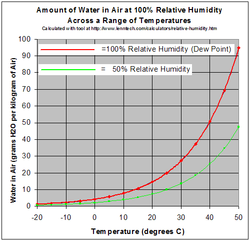jatoxico said:
I think a major point of that is being missed is that the MC of wood is calculated on a weight basis eg. 30g water per 100g of wood = 30% MC.
Relative humidity is not calculated this way. From the attached chart notice that at 20 C (around 70 F) the actual amount of water on a g basis is only 8g/1000g air at 50% Rel Humidity and 15g/1000g at 100%.
Yes, the RH of air is temperature dependent while the MC of wood is not. Heating up a split with 50% MC will not change the amount of water it can hold. I don't see how this fact changes anything. Water molecules will leave the surface of the wood at a faster rate when the RH is low than when it is high. That's where the dehumidifier comes in.
Since the only way water can leave the split is directly from the surface into the air, water inside the split must migrate to the surface across a diffusion gradient that is established by the water leaving at the surface. Therefore, the faster the water leaves the surface (i.e. the lower the RH), the steeper the gradient becomes, and the faster water molecules will migrate out of the inner portions of the split, and the faster the entire split will dry. That's why I said earlier that RH is what drives the entire process, not temperature
per se.
Heating up the air in the basement
will lower the RH and allow water to leave the wood surface faster. That's why this process works so much better in the dead of winter. The frigid outside air contains very little water even at a high RH. As that air infiltrates into the heated spaces, the RH drops like a stone and rapid drying begins. In a naturally ventilated system like a home, the moisture that leaves the wood soon exits the living space as new dry air moves in from the outside.
With a dehumidifier, the water is removed from the air by the cold condensation coils of the dehumidifier (which are well below the dew point) and drips into a container to be removed, or is drained away continuously through a hose or pipe of some sort. There is no need to continually introduce fresh air into the storage place because the air is continually being dried by the condensation process itself.
FWIW their are two principle methods for calculating the MC in wood. The one you mentioned - wet-basis - is the most intuitive way, but it is not the way MC is expressed by wood technologists. They use a method of calculation called
dry-basis. It is the weight of the water divided by the dry weight of the wood fibers themselves. Wood that is 30% water by weight is 70% dry wood fiber by weight. 30÷70 = .429 X 100 = 42.9% MC
dry-basis. It is crucial to understand this point if you are using a moisture meter to judge the readiness of your wood. After all, fresh-cut white ash that might read 42.9% MC on a meter (dry-basis) is durn near ready to burn just as it is (and some folks do burn fresh-cut ash with success), whereas wood that might be 42.9% MC wet-basis like red oak (70% MC dry-basis) will hardly ignite.


